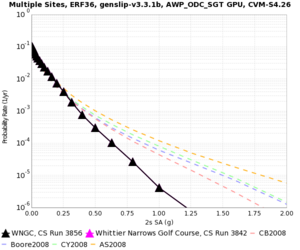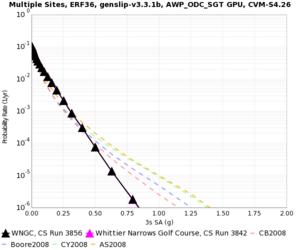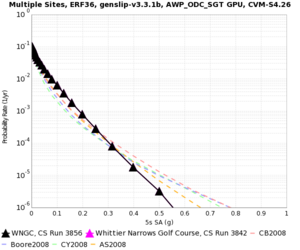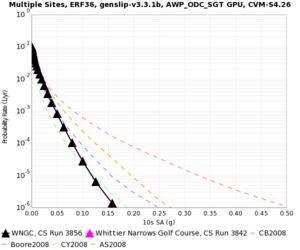CyberShake Study 15.4
CyberShake Study 15.3 is a computational study to calculate one physics-based probabilistic seismic hazard model for Southern California at 1 Hz, using CVM-S4.26, the GPU implementation of AWP-ODC-SGT, the Graves and Pitarka (2015) rupture variations with uniform hypocenters, and the UCERF2 ERF. The SGT calculations will be split between NCSA Blue Waters and OLCF Titan, and the post-processing will be done entirely on Blue Waters. The goal is to calculate the standard Southern California site list (286 sites) used in previous CyberShake studies so we can produce comparison curves and maps, and data products for the UGMS Committee.
Contents
Preparation for production runs
Check list of Mayssa's concernsUpdate DAX to support separate MD5 sumsAdd MD5 sum job to TCEvaluate topology-aware schedulingGet DirectSynth working at full run scale, verify resultsModify workflow to have md5sums be in parallel- Test of 1 Hz simulation with 2 Hz source - 2/27
Add a third pilot job type to Titan pilots - 2/27- Run test of full 1 Hz SGT workflow on Blue Waters - 3/4
- Add cleanup to workflow and test - 3/4
- Test interface between Titan workflows and Blue Waters workflows - 3/4
- Add restart capability to DirectSynth - 3/6
- Simulate curves for 3 sites with final configuration; compare curves and seismograms - 3/11
- File ticket for 90-day purged space at Blue Waters - 3/13
- File ticket for reservation at Blue Waters, along with justification - 3/13
- Follow up on high priority jobs at Titan - 3/13
- Create study description file for Run Manager - 3/13
- Science readiness review - 3/18
- Technical readiness review - 3/18
Computational Status
We are hoping to begin this study in early March.
Data Products
Goals
Verification
DirectSynth
A comparison of 1 Hz results with SeisPSA to results with DirectSynth for WNGC. SeisPSA results are in magenta, DirectSynth results are in black. They're so close it's difficult to make out the magenta.
| 2s | 3s | 5s | 10s |
|---|---|---|---|



